

 Kentucky's tobacco growers have multiple, foliar fungicide
options for disease-control in their tobacco fields, although
the number available is still low. Foliar applied products can
be important tools for controlling diseases, especially blue
mold and bacterial leaf spots, in the tobacco field when used
correctly. However, we still do not have available effective
fungicides for some important foliar diseases of tobacco,
especially target spot and frogeye.
Kentucky's tobacco growers have multiple, foliar fungicide
options for disease-control in their tobacco fields, although
the number available is still low. Foliar applied products can
be important tools for controlling diseases, especially blue
mold and bacterial leaf spots, in the tobacco field when used
correctly. However, we still do not have available effective
fungicides for some important foliar diseases of tobacco,
especially target spot and frogeye.
Using the correct chemical, the proper rate, the appropriate application method, and at the correct timing are important to successful use of foliar-applied fungicides. All those currently labeled on tobacco will perform best when used prior to infection (in a preventive role) rather than waiting until the disease is damaging the crop, yet certain of these chemicals also have some rescue potential. For most foliar applications, thorough coverage is critical to success, especially under strong disease pressure. Consequently, a good sprayer specially equipped to deliver foliar protectant- type fungicides in a tall, dense, row-crop is needed. In fact, the failure to adopt proper spray equipment is the leading reason for lack of success with foliar fungicides in tobacco.
The Kentucky Blue Mold Warning System should be a excellent tool to assist growers in the need and timing of foliar fungicides in tobacco. Although this website mainly provides information on blue mold, advice is also provided on other tobacco diseases. That website is located at: http://www.uky.edu/Agriculture/kpn/kyblue/kyblue.htm
The chemical options listed below have proved effective in our experiments and demonstration trials and were labeled for the uses mentioned as of April 15, 2003. There may be others that are labeled for tobacco, but are not included here, because they have not proven to be effective under Kentucky's disease conditions, or in valid efficacy tests conducted by pathologists in other major tobacco production areas. Should any fungicide receive a tobacco label during the growing season, special updates will be provided in this newletter, plus it will be posted on the above website.
Not included below are chemicals which are reportedly being used and may even have proven efficacy, but that are not labeled for field-tobacco-use in Kentucky, including: Aliette, Bayleton, Benlate, Bleach, Captan, Flint, Nova, Quadris, Rovral, and Tilt. In addition to unlabeled uses being prohibited by state and federal pesticide laws, tobacco marketing laws also directly prohibit the marketing of tobacco treated with unlabeled chemicals. Therefore, the use of these unlabeled materials should be discouraged at all levels of the tobacco industry.
ACTIGARD 50WG has a federal label supporting use in blue mold control on both burley and dark tobaccos as a broadcast, foliar spray at 0.5 oz/acre, using 20-30 gallons of water per acre. The pattern of use in burley and dark tobaccos is very different from that labeled in flue cured tobacco, so read the label carefully. The preharvest interval is 21 days and the re-entry interval is 12 hours. Application cannot begin in burley and dark tobacco until after the plants reach a height of 18" (stalk length from bud to the soil line) due to serious phytotoxicity problems. A second application can be made 10 days later.
The active ingredient (acibenzolar-S-methyl or benzothiadiazole) is not directly toxic to the target pathogens. Instead, it is a plant defense activator that induces (triggers) a series of natural chemical reactions in the treated plant that activate the plant's own resistance mechanisms - called the SAR (systemic activated resistance, also called systemic acquired resistance). Consequently, disease control is normally not obtained until four or five days after the application is made and there may be other desirable and undesirable physiological changes that occur under certain conditions in the treated plant. The rate needs to be calculated carefully, as high rates can be very phytotoxic and lower rates greatly reduce efficacy. Yellowing of the foliage occurs during the time defense chemicals are present, but this yellowing and the control dissipate with time. It is important to control blue mold prior to the plants reaching the stage that Actigard can be used, as well as, in late-maturing varieties, by using additional fungicides when blue mold favorable periods exist. Follow directions carefully, in order to achieve the desired disease control without causing crop damage. Application rate and timing are critical to achieving control while minimizing the phytotoxicity. The label clearly states these "do nots" and I urge growers to follow label warnings:
ACROBAT MZ is labeled under a state label (24c) in Kentucky. This state label was renewed because the national label for Acrobat 50 WP was not made available in the Kentucky market. Acrobat MZ contains two fungicidal chemicals - the systemic dimethomorph and the protectant mancozeb. Acrobat MZ is labeled only as a foliar spray to be applied at 2.5 lbs/100 gallons/acre (volume adjusted for stage of growth). It is highly effective when applied well and at close intervals, even under aggressive disease pressure, but of limited value when applied poorly or the intervals are not maintained. Application can be made on a 5-7 day spray schedule, once advisories have been issued, but applications should be discontinued when and if the threat of blue mold subsides. Sprays should be applied in a preventive manner by ground-operated, high-pressure sprayers equipped with hollow-cone nozzles on drops, or with mist blowers or other air-blast equipment. Up to 8 applications can be made per crop, but the limit is 10.0 lbs/field/season, and with no more than 2.5 lbs/acre per application. The preharvest interval is 30 days between last application and harvest. When being used in a weekly spray schedule, this fungicide will also provide some control of frogeye leaf spot, brown spot and ragged leaf spot, but it is not specifically labeled for these. However, the greatest pressure for these diseases is after topping, so in reality, Acrobat MZ provides limited protection against these late season leaf spots. Also, it has not proven effective in the control of target spot in the field.
DITHANE DF RAINSHIELD was recently labeled under a state label, 24-c for use in the field. This special state label for the field was needed mainly to have a mixing partner for use with other foliar fungicides. Dithane DF applications need to be made as with Acrobat MZ but the rate is 1.5-2.0 lbs/100 gallons of water in weekly foliar sprays for blue mold prevention. To be effective, the fungicide mixture must be applied to achieve complete coverage of the plant's foliage. Sprays should be discontinued when the threat of blue mold no longer exists. This spray program will also assist in early season control of frogeye, brown spot and ragged leaf spot, but not target spot. The preharvest interval between last application and harvest is 30 days.
STREPTOMYCIN 17-21% [sold as Agri-Mycin 17, Agri- Strep 21, and others] @ 0.5 to 1.0 lbs/ 100 gallons of water is labeled for control of angular leaf spot and wildfire under a national label. Rarely is this material needed in the field, but if serious levels of angular leaf spot persist, then control can be achieved in most cases with streptomycin, if it is applied with a good sprayer. It has some systemic activity, but good coverage of at least one side of the leaf is important. If the disease is active at the time of the application, make the first spray at 1.0 lbs/ 100 gallons (200 ppm) then shift to lower rates until control has been achieved. These sprays may be repeated at 5 to 7 day intervals. For best results, make these applications late in the day or at night. Streptomycin is also labeled for control of blue mold, but we have had limited success in the lab and field against current isolates of blue mold using Streptomycin. Because bacterial diseases normally develop under very wet conditions in rapidly growing tobacco, having soil conditions to support spray equipment is often the limiting factor unless sod drivestrips are present.
For the latest blue mold status and other tobacco disease information, check the KY Blue Mold Warning System online.
![]() http://www.uky.edu/Agriculture/kpn/kyblue/kyblue.htm
http://www.uky.edu/Agriculture/kpn/kyblue/kyblue.htm

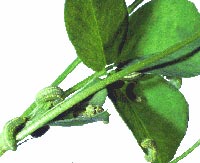 The alfalfa weevil can be a serious pest on the first cutting
and fields should be examined to determine if damaging
levels of this insect are present. These small legless grubs
first feed in the tips then move down the plant to chew on
expanded leaves. Application of an insecticide can be
justified if tip feeding is present on 25% to 50% of the stems
and 2 or more live weevil larvae are present. Be careful
when using tip damage to assess fields, it is easy to be
drawn to hot spots or to selectively pick damaged tips.
The alfalfa weevil can be a serious pest on the first cutting
and fields should be examined to determine if damaging
levels of this insect are present. These small legless grubs
first feed in the tips then move down the plant to chew on
expanded leaves. Application of an insecticide can be
justified if tip feeding is present on 25% to 50% of the stems
and 2 or more live weevil larvae are present. Be careful
when using tip damage to assess fields, it is easy to be
drawn to hot spots or to selectively pick damaged tips.
Early harvest is a control option. If flower buds are present on 30% or more of the stems, hay quality should be good and many of the weevil larvae will perish. Survival can be good under windrows where the weevil grubs are protected from drying out and can feed on protected hay. Fields cut to control weevils should be checked 7 to 10 days after harvest to see if new growth is developing and not being chewed off by larvae or newly emerging adults. This injury can be ended using a stubble spray.
Weevil larvae feed for about three weeks but egg hatch occurs over a an extended period of time so the "weevil season" can last for four to five weeks. Mature weevil larva will spin a loose white cocoon at the top of the plant and an adult will emerge about 10 days later. Adults will feed for a time before leaving the field to hide for the summer. They will return in the fall.
Spring seeded alfalfa or established fields that will not be cut for another three to four weeks can be hit by potato leafhoppers. It is too early yet for damaging numbers of this insect but they will be moving into alfalfa before long and can reach injury levels my late May.
See Insect Recommendations for more alfalfa pest recommendations.
In research plots outside of Lexington, an alfalfa variety susceptible to Sclerotinia crown and stem rot exhibited continued disease development during the past few weeks. The level of stand loss progressed from 50% in the susceptible check to 85% over the past several weeks. The region has experienced several periods of warm, dry weather this past month, which can often irreversibly shut down disease progress. However, we have also had two periods in the past month of frequent rainfall over a period of several days, which evidently favored continued disease activity.
It is unknown whether the continuing disease progression observed recently was due to continued development of primary infections or to the spread of secondary infections; nevertheless, substantial disease progress developed in the past few weeks. Alfalfa producers who seeded last autumn should scout their fields to assess the level of loss from Sclerotinia, even if they did so earlier this month.

 As of right now, the wheat disease situation in Kentucky
appears to be very quiet. Phil Needham, a crop consultant
with Miles Opti-Crop in Owensboro, indicated that as of
Thursday, he was seeing very light disease pressure in
southern Kentucky and the Owensboro area. He and his
field scouts have seen low levels of speckled leaf blotch
(Septoria tritici) in many fields. Powdery mildew levels are
also low, overall. However, expect both of these diseases to
increase as a result of the cool, rainy weather we are
having. Obviously, both diseases will be restricted on
resistant varieties.
As of right now, the wheat disease situation in Kentucky
appears to be very quiet. Phil Needham, a crop consultant
with Miles Opti-Crop in Owensboro, indicated that as of
Thursday, he was seeing very light disease pressure in
southern Kentucky and the Owensboro area. He and his
field scouts have seen low levels of speckled leaf blotch
(Septoria tritici) in many fields. Powdery mildew levels are
also low, overall. However, expect both of these diseases to
increase as a result of the cool, rainy weather we are
having. Obviously, both diseases will be restricted on
resistant varieties.
Phil also indicated his scouts are seeing very low levels of leaf rust around the edges of some fields. This is a significant concern for fields planted to rust-susceptible varieties. With the snow cover we had this winter, there is a good chance that some rust overwintered in Kentucky. Interestingly enough, leaf rust levels in the lower mid- south are reported to be lower than normal. Leaf rust can get out of hand quickly during warm and wet seasons. So it would behoove all farmers and crop consultants to go out and look for rust now to establish a baseline; then begin to monitor progress of the disease. Headline, Quadris, Stratego and Tilt all do a very good to excellent job of controlling rust before a leaf rust epidemic kicks in gear. However, failure to catch the disease early in the outbreak could greatly limit the value of all of these fungicides for rust control. It is very unlikely that any field needs to be sprayed now for rust, so time is on our side.
Finally, it looks as though we have dodged the soil-borne viruses this year. Similarly, as of now, barley yellow dwarf is at very low levels. This could change, so I am not prepared to say we are out of the woods yet. If any given field is free of symptoms through flag leaf emergence, then little yield impact would be expected, even if late symptoms developed. Very late symptom expression indicates the involvement of spring infections. The expression, or lack of expression, of Barley Yellow Dwarf Virus symptoms over the next 10 days will tell us where the wheat crop is in regards to infections by BYDV.
One last word of caution. There are reports that stripe rust is more severe than normal in some southern states this spring. Stripe rust is favored by the kind of weather we are having right now (on the cool side and wet). To my knowledge, we have never had a stripe rust epidemic in Kentucky, but it could happen. The prudent thing to do would be to begin scouting now just to verify that stripe rust is not an issue. And keep looking periodically. It is easy to identify and will appear as very bright yellow-orange pustules in dashes on leaves. I have seen it here before, so it is a concern. Like leaf rust, it is not difficult to control with fungicides if sprays are applied before the disease gets rolling.
 I have several reports of large numbers (= pretty easy to
find) of aphis on the lower stems of wheat. This appears to
be most common in very thick stands. While the discovery
of these aphids is too late to make any difference in Barley
yellow dwarf, they could potentially be a problem from
direct feeding.
I have several reports of large numbers (= pretty easy to
find) of aphis on the lower stems of wheat. This appears to
be most common in very thick stands. While the discovery
of these aphids is too late to make any difference in Barley
yellow dwarf, they could potentially be a problem from
direct feeding.
In Kentucky we do not often have problems with late feeding aphids. The chance of having this problem is increased by cool, wet spring weather, very dense stands, and high nitrogen use rates.
At this time of year it is really important to know with which aphid you are dealing. We generally worry about the bird cherry - oat aphid (BCOA) during the fall and winter. This is the aphid most responsible for moving the Barley yellow dwarf virus in our wheat. However, as warm weather develops, populations of this aphid will begin to decline. If the aphids you are finding now are BCOA they will likely disappear before head emergence, and no control will be needed. If however, the aphids you are finding are English grain aphids (EGA), they will tend to increase with warm weather. When we have problems with aphid infestation of wheat heads it is usually with English grain aphid.
These two aphids are relatively easy to tell apart. The BCOA is darker, often with a red or orange area surrounding the cornicles (tail pipes) The cornicles are relatively short and black. Their antennae are not noticeably long. The EGA is a much lighter color of green often running to a pinkish or brownish shade and do not have the orange-red area around the cornicles. Their cornicles are relatively long and black. The Antennae EGA are very long, often ½ to 3/4 the length of their bodies.
Aphid feeding on vegetative plant parts is of very little concern, even if large numbers of aphids are present. The problem occurs when these populations move into the heads during the grain filling stage. When this occurs it can reduce grain yields and perhaps more commonly can reduce test weight.
Watch for and identify these aphids now. This will aid you with any decision that may need to be made during head filling time.
See "Insect Management Recommendations" for more wheat pest information.
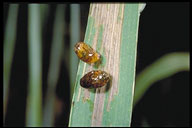 Cereal leaf beetle (CLB) larvae are out and active. The ones
I have seen so far look like very tiny grubs and have not yet covered
themselves with trash. Very little feeding damage was
evident. In general this insect does very little damage, but
can be quite a problem, especially if they feed extensively
on the Flag and F1 leaves.
Cereal leaf beetle (CLB) larvae are out and active. The ones
I have seen so far look like very tiny grubs and have not yet covered
themselves with trash. Very little feeding damage was
evident. In general this insect does very little damage, but
can be quite a problem, especially if they feed extensively
on the Flag and F1 leaves.
At this time you will be seeing the larval (young) stage. They look like tiny slugs, are shiny and may be yellow to dark in color. As they increase in size they will begin to "glue" pieces of leaf material and other trash on their backs as a form of camouflage. They are often described as looking like "bird droppings"
This early in the season you may also find CLB eggs. These are yellow, football shaped, and are usually found in small groups of 2-10 or so. The eggs are attached to the plant tissue with one of the pointy ends.
When adults emerge they will be 1/2" long shiny black beetles with a red area behind the head and red legs. The adults and larvae do the same type damage.
Damage symptoms are very diagnostic. The eat out the surface tissue between leaf veins, leaving the lower surface intact. This produces white parallel streaks in the leaf. The damage is easer to see than the insect. However, the object should be to find the insect before finding many of these white streaks.
Scout for these insects by examining ten randomly chosen tillers, in ten different locations in the field. This will produce a total of 100 tillers examined. Check all the leaves and stems for cereal leaf beetle eggs, grubs and adults. Note the number of tillers infested, the number CLB eggs and the number of CLB grubs and adults. You will need to know if egg hatch is in the early stages or about finished. If you do not find any eggs or if eggs represent less than 50% of the CLB you find, then you don't need to count again. If however, eggs represent more than 50% of the CLB you find, then you need to sample again in five to seven days. This insect will only have one generation that is important to wheat.
Your wheat will be most susceptible to this insect between Feekes Growth stages 8 and 10.1. The flag and F1 leaves are what needs to be protected.
If you are producing very high value wheat (either very high yielding or high quality or wheat carrying a specific trait) you should consider control if on average you find one CLB larva or adult for every four tillers. This threshold is based on work done in North Carolina and Virginia. They generally have a better maturing season then we do, so the threshold is very conservative for Kentucky.
If your wheat is not of the highest value the threshold is likely to be nearer to one CLB per tiller.
See "Insect Management Recommendations" for more wheat pest information.
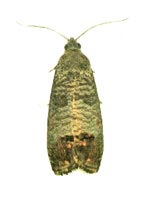 We are beginning to see the first codling moth activity in
traps in Kentucky. Many orchards may have already
reached the biofix, that's the fifth moth captured per trap.
This means that you need to be watching trap catches very
closely, at least twice a week.
We are beginning to see the first codling moth activity in
traps in Kentucky. Many orchards may have already
reached the biofix, that's the fifth moth captured per trap.
This means that you need to be watching trap catches very
closely, at least twice a week.
When the fifth moth is captured, called the biofix date, you will need to begin accumulating degree days. A degree day is when the average temperature for a 24-hour period is one degree over 50F. For example, if the high yesterday was 65F and the low 45F, then the average would have been 55F. We would have measured 5 degree days yesterday (55F - 50F = 5 degree days). Once you have reached the biofix date (fifth moth), you begin accumulating the degree days and use this to time the codling moth sprays.
With the newer materials for codling moth control, some products need to be applied earlier, others later. The newer products are very sensitive to proper timing, they may not work if applied at the same time that Guthion or Imidan was applied in the past. The table below lists some of the recommended target timings for these sprays.
Guthion/Imidan----------250 degree days
Assail 70 WP------------150 degree days
Danitol--------------------250 degree days
Confirm/Intrepid--------150 degree days
Esteem--------------------100 degree days
SpinTor-------------------200 degree days
San Jose Scale
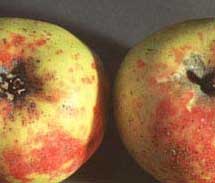 Damage by San Jose scale is evident in some orchards. In
some areas, levels have reached the point where portions of
the commercial orchards have been killed. San Jose scale
injects as toxin as it feeds, and large numbers can kill trees
in just a couple of years if not managed properly. The recent
loss of two insecticides has put our San Jose scale
management program in jeopardy, but the recent
registration of Esteem 35WP provides us with a new tool to
manage scale problems.
Damage by San Jose scale is evident in some orchards. In
some areas, levels have reached the point where portions of
the commercial orchards have been killed. San Jose scale
injects as toxin as it feeds, and large numbers can kill trees
in just a couple of years if not managed properly. The recent
loss of two insecticides has put our San Jose scale
management program in jeopardy, but the recent
registration of Esteem 35WP provides us with a new tool to
manage scale problems.
If you haven't done so already, you need to survey you orchard for SJS, and if it is a problem, then use Esteem when the crawlers are active. Electrical tape wrapped sticky-side out on scaffold limbs can be used to monitor for the crawlers. Generally, crawlers will emerge between about the 20th of May and June 1.
Plum Curculio
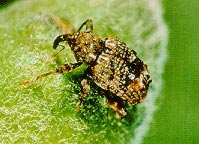 Plum curculio has begun egg laying and scarring of young
fruit in central Kentucky. Small, 1-2 mm crescent-shaped
scars on the fruit are signs of the damage. These wounded
areas will become dime-sized lesions on the surface of
apples at harvest. Considerable damage can occur over a
short period of time with this pest. Plum curculio is
controlled at petal fall or first cover with an application of
Imidan, Guthion, Danitol, or Avuant.
Plum curculio has begun egg laying and scarring of young
fruit in central Kentucky. Small, 1-2 mm crescent-shaped
scars on the fruit are signs of the damage. These wounded
areas will become dime-sized lesions on the surface of
apples at harvest. Considerable damage can occur over a
short period of time with this pest. Plum curculio is
controlled at petal fall or first cover with an application of
Imidan, Guthion, Danitol, or Avuant.
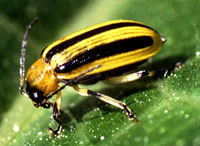
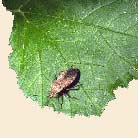 Production of transplant is underway for the cucurbit
crops, melons, cucumbers, squash, and watermelons. While
many growers are well aware of the threat posed by
cucumber beetles, squash bugs, and the devastating
diseases that they transmit in the field, some overlook this
in the greenhouse. These insects have the ability to attack
these crops in the greenhouse and transmit the bacterial
agents that cause bacterial wilt and yellow vine decline
before the plants ever reach the field. Growers of these
transplants must take preventive steps to ensure that these
insects do not feed on the plants while they are in the
greenhouse or out of the greenhouse hardening off before
going to the field.
Production of transplant is underway for the cucurbit
crops, melons, cucumbers, squash, and watermelons. While
many growers are well aware of the threat posed by
cucumber beetles, squash bugs, and the devastating
diseases that they transmit in the field, some overlook this
in the greenhouse. These insects have the ability to attack
these crops in the greenhouse and transmit the bacterial
agents that cause bacterial wilt and yellow vine decline
before the plants ever reach the field. Growers of these
transplants must take preventive steps to ensure that these
insects do not feed on the plants while they are in the
greenhouse or out of the greenhouse hardening off before
going to the field.

Last week, daylily rust was discussed in this newsletter.
Recent specimens with symptoms similar to rust were
observed in the plant disease diagnostic laboratory this
week. However, the daylily disease we are seeing now is
not rust. It appears to be daylily leaf blight, caused by an
anthracnose-like fungus. Daylily growers looking for rust
need to examine the diseased tissues carefully and note the
presence, or not, of rust pustules with red-orange spores.
Recent periods of moist weather have favored foliar diseases
of many types.
Official notification was received by the U.K. Plant Pathology Department that race 3, biovar 2 Ralstonia solanacearum was confirmed by USDA using PCR on a sample of geraniums submitted from a greenhouse in western Kentucky. The confirmation was signed on March 31, 2003. The specimens were collected on March 17, 2003 by authority of USDA - APHIS-PPQ by Joe Collins, Nursery Inspector with the Office of Kentucky State Entomologist. He submitted it initially to the UK Plant Disease Diagnostic Lab in Lexington and the lab found symptoms and, after culturing, signs consistent with Ralstonia solanacearum and it tested positive for this bacterium using ELISA. USDA confirmation of race 3, biovar 2 of Ralstonia here would result in destruction of infected plants See Kentucky Pest News # 977, March 10, 2003 for more details on this new Ralstonia strain and the threat it could pose to Kentucky agriculture.
Cedar-apple rust, cedar-quince rust, and cedar-hawthorn rust have been visible and active on cedars and Junipers during the past week. The bright orange gelatinous telial horns (fungal fruiting structures) have been highly visible whenever there has been rain or moist conditions.
Cedar-apple rust. Spores from the cedar-apple rust fungus, which forms the large golf-ball-sized galls which expand to the size of an orange colored baseball when wet, will be infecting leaves and sometimes flowers and fruits of apple and crabapple now.
Cedar-hawthorn rust. Similarly, spores of the cedar-hawthorn rust fungus, which forms the pea-sized galls which expand to orange gelatinous structures up to an inch in diameter are infecting hawthorn leaves now.
Cedar-quince rust. Cedar quince rust does not form galls on cedars and junipers, but instead causes twig and branch cankers. These twig and branch segments can be observed during wet weather as an orange, gelatinous coating on these cankers. Cedar quince rust will infect fruits of hawthorns, apples, and crabapples and will infect small twigs and branches of these trees as well. Expect additional infections of hawthorns, apples, and crabapples by these rust fungi for the next week or two. Symptoms on these hosts will appear in a month or two.

On tobacco last week we received samples of Rhizoctonia damping off, Pythium root rot, Sclerotinia collar rot, cold injury, stunting and general problems from wet soil media, and chemical injuries.
On greenhouse ornamentals and vegetable transplants, we saw Pythium root rot on geranium; and chemical injury on alyssum, petunia, ornamental sweet potato, and tomato. On landscape ornamentals, we saw Botryosphaeria canker on crabapple; cedar apple rust on juniper; Entomosporium leaf spot on Photinia; and general spring yellowing and leaf drop (older leaves) on holly.

UKREC-Princeton, KY, April 18 - 24| Black cutworm
| 2
| True armyworm
| 44
| European corn borer
| 0
| Southwestern corn borer
| 0
| Corn earworm
| 20
| | |
NOTE: Trade names are used to simplify the information presented in this newsletter. No endorsement by the Cooperative Extension Service is intended, nor is criticism implied of similar products that are not named.
Lee Townsend
Extension Entomologist